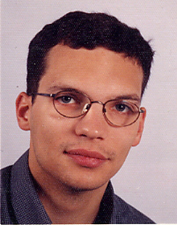
 |
| Home | Mission | Research | Members | Positions | Image Gallery | Intranet | Links | Contact | Seminars | Search |
Dr. Martin Ulmschneider
|
| Structural
Bioinformatics and Computational Biochemistry Unit Department of Biochemistry University of Oxford South Parks Road Oxford OX1 3QU United Kingdom Tel: +44 (0)1865 275380 Fax: +44 (0)1865 275273 E-mail: ulmschne@caspur.it |
 |
Implicit solvent model development for simulation of
membrane protein folding and function
|
|
Collaborations |
|
|
Prof. A. Di Nola
and Dr. J.
Ulmschneider, Department of Chemistry, University of Rome "La Sapienza",
Rome, Italy |
|
| Dr. F. Momburg, German Cancer Research Center (DKFZ), Heidelberg, Germany | |
| Dr. I. Daidone, Computational Molecular Biophysics Group, University of Heidelberg, Germany | |
Publications |
|
| J.P. Ulmschneider, M.B. Ulmschneider
& A. Di Nola, Monte Carlo versus Molecular Dynamics for all atom
polypeptide simulations, Submitted, J. Phys. Chem. B 2006 M.B. Ulmschneider,
J.P. Ulmschneider, A. Di Nola & M.S.P.
Sansom, A generalized born implicit membrane representation based on
experimental insertion free energies, Accepted, Biophys. J. 2006 |
|
| Last updated 27/01/2006 |